世界鱼类(第三版)Fishes of the World 3rd edition (introduction)
- 格式:pdf
- 大小:1.14 MB
- 文档页数:18
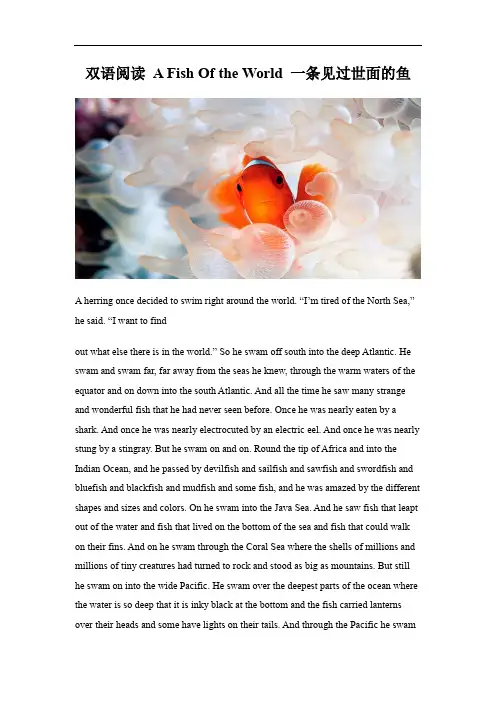
双语阅读 A Fish Of the World 一条见过世面的鱼A herring once decided to swim right around the world. “I’m tired of the North Sea,” he said. “I want to findout what else there is in the world.” So he swam off south into the deep Atlantic. He swam and swam far, far away from the seas he knew, through the warm waters of the equator and on down into the south Atlantic. And all the time he saw many strange and wonderful fish that he had never seen before. Once he was nearly eaten by a shark. And once he was nearly electrocuted by an electric eel. And once he was nearly stung by a stingray. But he swam on and on. Round the tip of Africa and into the Indian Ocean, and he passed by devilfish and sailfish and sawfish and swordfish and bluefish and blackfish and mudfish and some fish, and he was amazed by the different shapes and sizes and colors. On he swam into the Java Sea. And he saw fish that leapt out of the water and fish that lived on the bottom of the sea and fish that could walk on their fins. And on he swam through the Coral Sea where the shells of millions and millions of tiny creatures had turned to rock and stood as big as mountains. But still he swam on into the wide Pacific. He swam over the deepest parts of the ocean where the water is so deep that it is inky black at the bottom and the fish carried lanterns over their heads and some have lights on their tails. And through the Pacific he swamand then he turned north and headed up to the cold Siberian Sea where huge white icebergs sailed past him like mighty ships, and still he swam on and on and into the frozen Arctic Ocean where the sea is forever covered in ice. And on he went past Greenland and Iceland and finally he swam home into his own North Sea. All his friends and relations gathered around and made a great fuss of him. They had a big feast and offered him the very best food they could find, but the herring just yawned and said, “I’ve swum around the entire world. Ive seen everything there is to see and I have eaten more exotic and wonderful dishes than you could possibly imagine.” And herefused to eat anything. Then his friends and relations begged him to come home and live with them. But he refused. “I’ve been everywhere there is and that old rock is too dull and small for me.” And he went off and lived on his own.And when the breeding season came, he refused to join in the spawning, saying, “I’ve swum around the entire world. And now I know how many fish there are in the world.I can’t be interested in herrings anymore. Eventually, one of the oldest of the herrings swam up to him and said, “Listen, if you don’t spawn with us, some herrings eggs will go unfertilized and will not turn into healthy young herrings. If you don’t live with your family, you’ll make them sad and if you don’t eat, you’ll die.”But the herring said, “I don’t mind. Ive been everywhere there is to go, Ive seen everything there is to see, andnow I know everything there is to know.”The old fish shook his head. “No one has ever seen everything there is to see,” he said. “Nor known everything there is to know.”“Look,” said the herring, “I’ve swum through the North Sea, the Atlantic Ocean, the Indian Ocean, the Java Sea, the Coral Sea, the Great Pacific Ocean, the Siberian Sea, and the frozen Arctic. Tell me, what else is there for me to see or know?”“I don’t know,” said the old herring. “But there may be something.”Well just then, a fishing boat came by, and all the herrings were caught in a net and taken to market that very day. And a man bought the herring and ate it for his supper, and he never knew that it had swum right around the world and had seen everything there was to see, and knew everything there was to know.从前,有一条青鱼决心要环游世界。
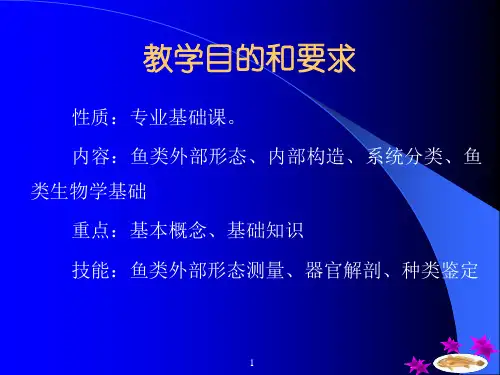
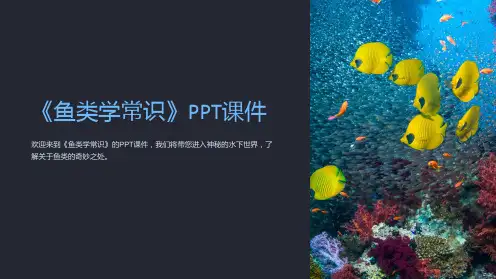
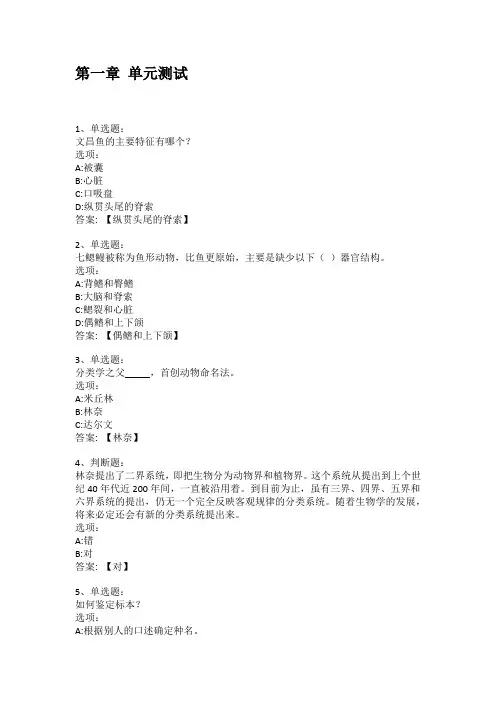
第一章单元测试1、单选题:文昌鱼的主要特征有哪个?选项:A:被囊B:心脏C:口吸盘D:纵贯头尾的脊索答案: 【纵贯头尾的脊索】2、单选题:七鳃鳗被称为鱼形动物,比鱼更原始,主要是缺少以下()器官结构。
选项:A:背鳍和臀鳍B:大脑和脊索C:鳃裂和心脏D:偶鳍和上下颌答案: 【偶鳍和上下颌】3、单选题:分类学之父_____,首创动物命名法。
选项:A:米丘林B:林奈C:达尔文答案: 【林奈】4、判断题:林奈提出了二界系统,即把生物分为动物界和植物界。
这个系统从提出到上个世纪40年代近200年间,一直被沿用着。
到目前为止,虽有三界、四界、五界和六界系统的提出,仍无一个完全反映客观规律的分类系统。
随着生物学的发展,将来必定还会有新的分类系统提出来。
选项:A:错B:对答案: 【对】5、单选题:如何鉴定标本?选项:A:根据别人的口述确定种名。
B:根据鱼皮或一两块骨骼的鉴定来确定种名。
C:根据绘图的形态的相似性的判断确定种名。
D:首先采集标本,并记录地点和时间及环境要素;再按形态测量计数表进行测量和数计等,每种(每地)25尾以上最好,求平均数、标准差等数据以便比较;结果符合种类检索表或物种描述的即可确定种类,写好学名。
答案: 【首先采集标本,并记录地点和时间及环境要素;再按形态测量计数表进行测量和数计等,每种(每地)25尾以上最好,求平均数、标准差等数据以便比较;结果符合种类检索表或物种描述的即可确定种类,写好学名。
】6、多选题:鱼的主要特征有()。
选项:A:有上下颌。
B:体外一般被有鱼鳞,且有完整的外骨骼系统。
C:有了成对的附肢——偶鳍。
D:脑和感觉器官更为发达。
E:终生生活在水中,用鳃呼吸。
答案: 【有上下颌。
;有了成对的附肢——偶鳍。
;脑和感觉器官更为发达。
;终生生活在水中,用鳃呼吸。
】7、判断题:鱼类和鱼形动物的区别主要在于口与鳃结构的基本不同。
选项:A:错B:对答案: 【对】8、单选题:以下不属于分类的作用的是()。
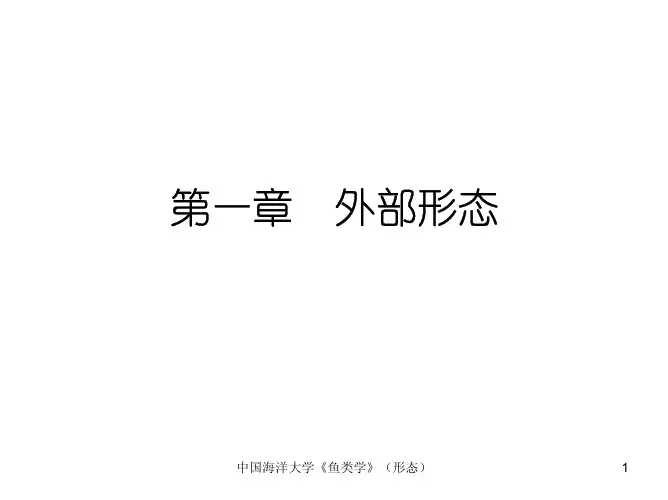
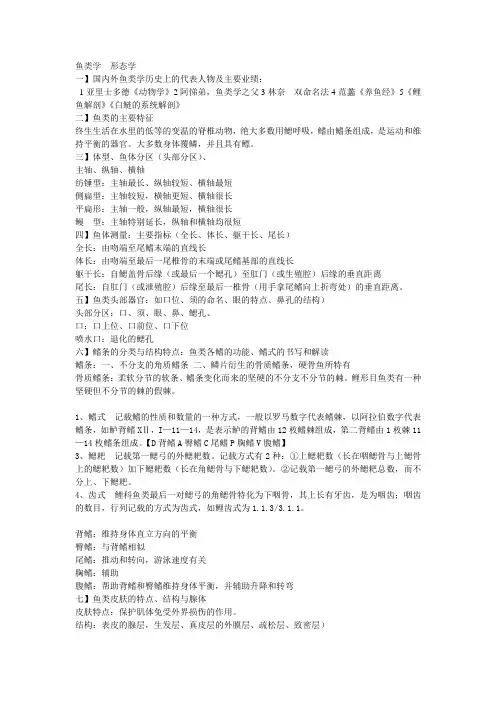
鱼类学形态学一】国内外鱼类学历史上的代表人物及主要业绩:1亚里士多德《动物学》2阿悌弟,鱼类学之父3林奈---双命名法4范蠡《养鱼经》5《鲤鱼解剖》《白鲢的系统解剖》二】鱼类的主要特征终生生活在水里的低等的变温的脊椎动物,绝大多数用鳃呼吸,鳍由鳍条组成,是运动和维持平衡的器官。
大多数身体覆鳞,并且具有鳔。
三】体型、鱼体分区(头部分区)、主轴、纵轴、横轴纺锤型:主轴最长、纵轴较短、横轴最短侧扁型:主轴较短,横轴更短、横轴很长平扁形:主轴一般,纵轴最短,横轴很长鳗型:主轴特别延长,纵轴和横轴均很短四】鱼体测量:主要指标(全长、体长、躯干长、尾长)全长:由吻端至尾鳍末端的直线长体长:由吻端至最后一尾椎骨的末端或尾鳍基部的直线长躯干长:自鳃盖骨后缘(或最后一个鳃孔)至肛门(或生殖腔)后缘的垂直距离尾长:自肛门(或泄殖腔)后缘至最后一椎骨(用手拿尾鳍向上折弯处)的垂直距离。
五】鱼类头部器官:如口位、须的命名、眼的特点、鼻孔的结构)头部分区:口、须、眼、鼻、鳃孔、口:口上位、口前位、口下位喷水口:退化的鳃孔六】鳍条的分类与结构特点:鱼类各鳍的功能、鳍式的书写和解读鳍条:一、不分支的角质鳍条二、鳞片衍生的骨质鳍条,硬骨鱼所特有骨质鳍条:柔软分节的软条、鳍条变化而来的坚硬的不分支不分节的棘。
鲤形目鱼类有一种坚硬但不分节的棘的假棘。
1、鳍式记载鳍的性质和数量的一种方式,一般以罗马数字代表鳍棘,以阿拉伯数字代表鳍条,如鲈背鳍XⅡ,I—11—14,是表示鲈的背鳍由12枚鳍棘组成,第二背鳍由1枚棘11—14枚鳍条组成。
【D背鳍A臀鳍C尾鳍P胸鳍V腹鳍】3、鳃耙记载第一鳃弓的外鳃耙数。
记载方式有2种:①上鳃耙数(长在咽鳃骨与上鳃骨上的鳃耙数)加下鳃耙数(长在角鳃骨与下鳃耙数)。
②记载第一鳃弓的外鳃耙总数,而不分上、下鳃耙。
4、齿式鲤科鱼类最后一对鳃弓的角鳃骨特化为下咽骨,其上长有牙齿,是为咽齿;咽齿的数目,行列记载的方式为齿式,如鲤齿式为1.1.3/3.1.1。
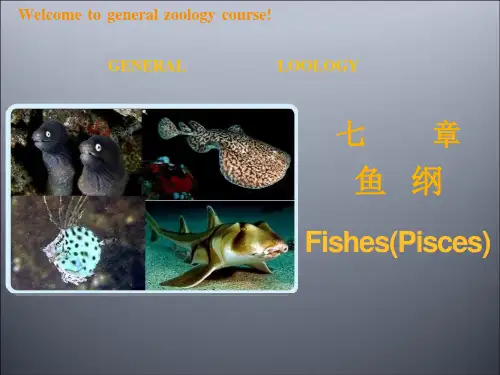
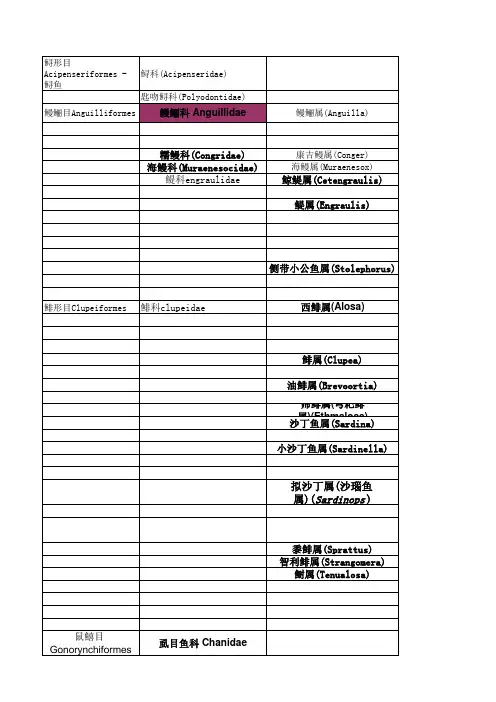
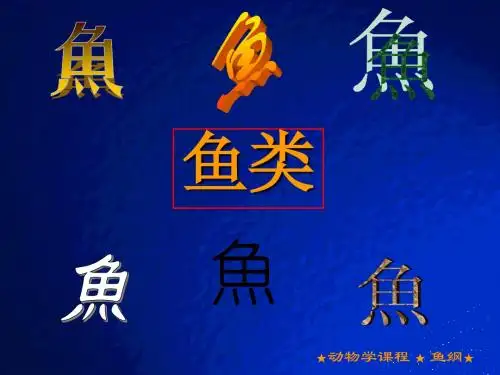
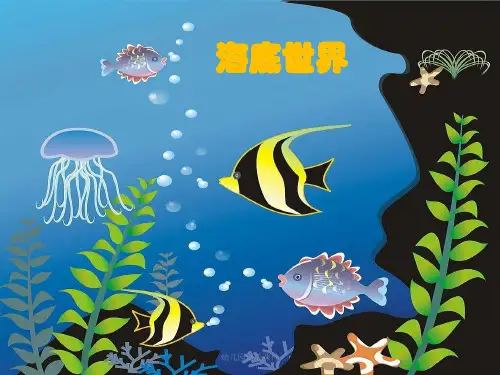

关于鱼的世界作文英语Title: Exploring the Enigmatic World of Fish。
The world beneath the surface of the water holds a mesmerizing array of life forms, each contributing to the intricate web of aquatic ecosystems. Among these, fish occupy a central role, displaying remarkable diversity in form, behavior, and habitat. Let us embark on a journey to explore the fascinating realm of fish.First and foremost, fish encompass a vast spectrum of species, ranging from the diminutive and translucent glass catfish to the majestic and elusive whale shark. With over 34,000 known species inhabiting freshwater, marine, and even brackish environments, fish demonstrate unparalleled adaptability to various aquatic habitats.One of the most intriguing aspects of fish biology is their diverse range of adaptations. Consider the remarkable camouflage abilities of the leafy seadragon, which blendsseamlessly into its surroundings, or the bioluminescent displays of deep-sea anglerfish, used to attract prey in the darkness of the abyssal depths. These adaptations highlight the ingenuity of nature in equipping fish with the tools necessary for survival in their respective environments.Furthermore, the behavior of fish showcases a rich tapestry of social interactions, communication strategies, and reproductive rituals. From the intricate courtship dances of tropical reef fish to the cooperative hunting techniques employed by certain species of sharks, fish exhibit complex behaviors that rival those of terrestrial animals. Studying these behaviors not only provides insight into the lives of fish but also offers valuable lessons in ecology and animal behavior.In addition to their biological significance, fish hold immense cultural and economic importance for humansocieties around the world. For millennia, fish have served as a vital source of sustenance for coastal communities and inland populations alike, providing essential nutrients andprotein to billions of people. Moreover, the fishingindustry supports millions of livelihoods globally, contributing significantly to local economies and international trade.However, the conservation of fish and their habitats faces numerous challenges in the modern era. Overfishing, habitat destruction, pollution, and climate change pose existential threats to many fish species and the ecosystems they inhabit. Efforts to mitigate these pressures require international cooperation, innovative conservation strategies, and sustainable management practices to ensure the long-term viability of fish populations and the ecosystems they support.Despite these challenges, there is cause for optimismin the ongoing efforts to protect and preserve fishdiversity worldwide. Conservation initiatives, such as marine protected areas, sustainable fisheries management, and community-based conservation projects, offer hope for the future of fish and their habitats. By raising awareness, promoting responsible stewardship, and fostering a deeperappreciation for the wonders of the aquatic world, we can work together to safeguard the rich legacy of fish for generations to come.In conclusion, the world of fish is a captivating realm teeming with diversity, complexity, and beauty. From the depths of the ocean abyss to the tranquil waters of freshwater rivers and lakes, fish occupy a unique and irreplaceable niche in the tapestry of life on Earth. By exploring and cherishing this extraordinary world, we gain not only a deeper understanding of nature but also a profound appreciation for the interconnectedness of all living beings. Let us continue to celebrate and protect the wondrous diversity of fish, ensuring a brighter future for our planet and all its inhabitants.。
文昌鱼目文昌鱼科偏文昌鱼科无颌上纲盲鳗纲盲鳗目盲鳗科十鳍甲纲头甲纲七鳃鳗目七鳃鳗科有颌上纲十盾皮鱼纲软骨鱼纲板鳃亚纲鲨形总目六鳃鲨目皱鳃鲨亚目皱鳃鲨科六鳃鲨亚目六鳃鲨科虎鲨目虎鲨亚目虎鲨科鼠鲨目锥齿鲨科剑吻鲨科鲭鲨科鎕鲨科大口鲨科姥鲨科长尾鲨科须鲨目须鲨亚目须鲨科橙黄鲨科鲸鲨亚目鲸鲨科真鲨目猫鲨科Scyliorhinidae皱唇鲨亚目Triakoidei拟皱唇鲨科Pseudotriakidae须皱唇鲨科Leptochariidae原鲨科Proscylliidae皱唇鲨科Triakidae真鲨亚目Carcharhinoidei真鲨科Carcharhinidae双髻鲨亚目Sphyrnoidei双髻鲨科Sphyrnidae角鲨目SQUALIFORMES角鲨亚目Squaloidei角鲨科Squalidae铠鲨科Dalatiidae棘鲨科Echinorhinidae锯鲨目PRISTIOPHORIFO-RMES锯鲨亚目Pristiophor0idei锯鲨科Pristiophoridae扁鲨目SQUA TINIFORMES扁鲨亚目Squatinoidei扁鲨科Squatinidae鳐形总目BA TOMORPHA 锯鳐目PRISTIFORMES锯鳐科Pristidae鳐形目RAJIFORMES犁头鳐亚目Rhinobatoidei圆犁头鳐科Rhinidae尖犁头鳐科Rhynchobatidae犁头鳐科Rhinobatidae团扇鳐科Platyrhinidae鳐亚目Rajoidei鳐科Rajidae无鳍鳐科Anacanthobatidae单鳍鳐科Arhynchobatidae若鳐科Pseudorajidae电鳐目TORPEDINIFORMES电鳐科T0rpedinidae单鳍电鳐科Narkidae无鳍电鳐科Temeridae鲼形目MYLIOBATIFORME8 鲽亚目Da8yatoidei扁鲽科Urolophidae六鳃鲽科Hexatrygonidae鲽科Dasyatidae江鲽科Potamotrygonidae燕鲽科Gymnuridae鲼亚目Myli0batoidei鲼科Myli0batidae鹞鲼科Aetobatidae牛鼻鲼亚目Rhin0pteroidei牛鼻鲼科Rhinopteridae蝠鲼亚目M0buloidei蝠鲼科Mobulidae全头亚纲HOLOCEPHALI银鲛目CHIMAERIFORMES银鲛科Chimaeridae长吻银鲛科Rhinochimaeridae叶吻银鲛科Callorhynchidae棘鱼纲ACANTHODII硬骨鱼纲OSTEICHTHYES—肺鱼亚纲DIPNEUSTI角齿鱼目CERATODONTIFO-RMES角齿鱼科Ceratodontidae美洲肺鱼目LEPIDOSIRENIF-ORMES美洲肺鱼科Lepidosirenidae非洲肺鱼科Protopteridae—总鳍亚纲CROSSOPTERYGII骨鳞总目OSTEOLEPIMO-RPHA腔棘鱼总目COELACANTHI-MORPHA腔棘鱼目COELACANTHIFO-RMES矛尾鱼科Latimeriidae—腕鳍亚纲BRACHIOPTERYGI多鳍鱼目POLYPTERIFORMES多鳍鱼科Polypteridae—辐鳍亚纲ACTINOPTERYGII ——软骨硬鳞下纲CHONDROSTEI鲟形目ACIPENSERIFORMES鲟科Acipenseridae匙吻白鲟科Polyodontidae——全骨鱼下纲HOLOSTEI雀鳝目LEPISOSTEIFORMES雀缮利Lepisosteidae弓鳍鱼目AMIIFORMES弓鳍鱼科Amiidae——真骨鱼下纲TELEOSTEI骨舌鱼总目OSTEOGLOSSO-MORPHA骨舌鱼目OSTEOGLOSSIFO-RMES骨舌鱼亚目Oste0glossoidei骨舌鱼科Osteoglossidae蝶齿鱼科Pantod0ntidae弓背鱼亚目Notopteroidei月目鱼科Hiodontidae弓背鱼科Notopteridae长颌鱼亚目Mormyroidei长颌鱼利Mormyridae裸臀鱼科Gymnarchidae海鲢总目ELOPOMORPHA——海鲢目ELOPIFORMES海鲢亚目Elopoidei海鲢科Elopidae大海鲢科Megalopidae北梭鱼亚目Albuloidei北梭鱼科Albulidae——背棘鱼目NOTACANTHIFO-RMES海蜥鱼科Halosauridae背棘鱼科Notacanthidae离颌鱼科Lipogenyidae——鳗鲡目ANGUILLIFCRMES鳗鲡亚目Anguilloidei鳗鲡科Anguillidae康吉鳗科Congridae海鳗科Muraenesocidae异鳗科Heterenchelyidae蚓鳗科Moringuidae奇康吉鳗科Xenocongridae新鳗科Neenchelyidae油康吉鳗科Myrocongridae海鳝科Muraenidae月尾鳗科Cyematidae合鳃鳗科Synaphobranchidae前肛鳗科Dysommidae寄生鳗科Simenchelyidae蛇鳗科Ophichthidae鸭嘴鳗科Nettastomidae蠕鳗科Echelidae锯犁鳗科Serrivomeridae线口鳗科Nemichthyidae颈鳗科Derichthyidae大头鳗科Macrocephenchelyidae囊喉鱼亚目Sacc0pharyngoidei囊喉鱼科Sacc0pharyngidae宽咽鱼科Eurypharyngidae单颌鱼科Monognathidae————鲱形总目CLUPEOMORPHA鲱形目CLUPEIFORMES齿鲱科Denticepitidae鲱科CIupeidae鳀科Engraulidae宝刀鱼科Chirocentridae————骨鳔总目OSTARIOPHYSI鼠鱚目GONORYNCHIFO-RMES遮目鱼亚目Chanoidei遮目鱼科Chanidae鼠鱚亚目Gonorynchoidei鼠鱚科G0norynchidae克奈鱼亚目Knerioidei克奈鱼科Kneriidae枕枝鱼科Phractolaemidae鲤形目CYPRINIFORMES双孔鱼科Gyrinocheilidae亚口鱼科(胭脂鱼科)Catostomidae鲤科Cyprinidae裸吻鱼科Psilorhynchidae鳅科C0bitidae平鳍鳅科Homalopteridae脂鲤目CHARACIFORMES鳡脂鲤科Hepsetidae琴鲤科Citharinidae间齿鱼科Hemiodontidae无齿脂鲤科Curimatidae上口脂鲤科Anostomidae大鳞脂鲤科Lebiasimidae胸斧鱼科Gasteropelecidae栉鳡科Ctenoluciidae脂鲤科Characidae鲇形目SILURIFORMES复须鲇科Diplomystidae叉尾鲴科Ictaluridae鲿科Bagridae长臀 科Cranoglanididae鲇科Siluridae锡伯鲇科Schilbidae鲽科Pangasiidae钝头 科Amblycipitidae平鳍鲇科Amphiliidae粒鲇科Akysidae鲍科Sisoridae胡鲇科Clariidae异囊鲇科Heteropneustidae海鲇科Ariidae鳗鲇科Plotosidae连尾鲍科Chacidae奥鲁鲇科Olyridae电鲇科Malapteruridae岐须鲍科Mochokidae棘鲇科Doradidae项鳍鲇科Auchenipteridae花鲇科Pimelodidae无须鲇科Ageneiosidae长臀鲇科Helogeneidae鲸鲇科Cetopsidae低眼鲇科Hypophthalmidae疣体鲇科Aspredinidae毛鼻鲇科Trichomycteridae美鲇科Callichthyidae甲鲇科Loricariidae星鲇科Astroblepidae裸背电鳗目GYMNOTIFORMES 鳍电鳗亚目Stern0pygoidei鳍电鳗科Sternopygidae吻电鳗科Rhamphichthyidae下电鳗科Hypopomidae线鳍电鳗科Apteronotidae裸背电鳗亚目Gymnotoidei电鳗科Electrophoridae————原棘鳍总目PROTACANTHO-PTERYGII 鲑形目SALMONIFORMES狗鱼亚目Es0C0idei狗鱼科Esocidae荫鱼科Umbridae水珍鱼亚目Argentin0idei水珍鱼总科Argentinoidea水珍鱼科Argentinidae深海鲑科Bathylagidae后肛鱼科Opisthoproctidae平头鱼总科Alep0cephal oidea平头鱼科Alepocephalidae发光鱼科Searsiidae鳞南乳鱼亚目Lepid0galaxioidei鳞南乳鱼科Lepid0galaxiidae鲑亚目Salmonoidei胡瓜鱼总科Osmeroidea胡瓜鱼科Osmeridae香鱼科Plecoglossidae银鱼科Salangidae桑达银鱼科Sundasalangidae南乳鱼总科Galaxioidea逆鳍鱼科Retropinnidae南乳鱼科Galaxiidae鲑总科Salmonoidea鲑科Salmonidae————巨口鱼总目STENOPTERYGII巨口鱼目STOMIIFORMES钻光鱼科Gonost0matidae褶胸鱼科Stern0ptychidae管发光鱼科Photichthyidae巨口鱼科Stomiidae蝰鱼科Chauli0dontidae星衫鱼科Astronesthidae奇棘鱼科I出acanthidae黑巨口鱼科Melanostomiidae柔骨鱼科Malacosteidae————灯笼鱼总目SCOPELOMORPHA 仙鱼目AULOPIFORMES仙鱼科Aulopodidae青眼鱼科Chlorophthalmidae珠目鱼科Scopelarchidae长体仙鱼科Notosudidae狗母鱼科Synodontidae管眼仙鱼科Giganturidae鲐蜥鱼科Paralepididae法老鱼科Anotopteridae齿口鱼科Evermannellidae锤颌鱼科Omosudidae帆蜥鱼科Alepisauridae丝鳍仙鱼科Pseudotrichonotidae灯笼鱼目MYCTOPHIFORMES灯笼鱼科Myctophidae新灯鱼科Neoscopelidae————副棘鳍总目PARACANTHO-PTERYGII鲑鲈目PERCOPSIFORME8鲑鲈亚目Percops0idei鲑鲈科Percopsidae胸肛鱼亚目Aphredoderoidei胸肛鱼科Aphredoderidae盲胸肛鱼科Amblyopsidae鳕形目GADIFORMES鳗鳞鳕亚目Muraenolepidoidei鳕亚目Gadoidei歪尾鳕科Euclichthyidae深海鳕科Moridae黑鳕科Melanonidae犀鳕科Bregmacerotidae鳕科Gadidae无须鳕科Merluccidae长尾鳕亚目Macr0uroidei长尾鳕科Macrouridae鼬鳚目OPHIDIIFORMES鼬鳚亚目Ophidioidei鼬鳚科Ophidiidae潜鱼科Carapidae胎鼬鳚亚目Bythitoidei胎鼬鳚科Bythitidae胶鼬鳚科Aphyonidae蟾鱼目BA TRACHOIDIFO-RMES蟾鱼科Batrachoididae鲩鲸目LOPHIIFORMES鲩鲸亚目L0phi0idei鲩鲸科Lophiidae躄鱼亚目Antennarioidei躄鱼科Antennariidae单棘躄鱼科Chaunacidae蝙蝠鱼科Ogcocephalidae澳大利亚躄鱼科Brachionichthyi-dae角鲩鲸亚目Ceratioidei新角鲩鲸科Neoceratiidae茎蟾鱼科Caulophrynidae黑角鲩鲸科Melanocetidae角鲩鲸科Ceratiidae双角鲩鲸科Diceratiidae长丝角鲩鲸科Gigantactinidae刺蟾鱼科Centrophrynidae长颌梦鱼科Thaumatichthyidae鞭冠鱼科Himantolophidae树须鱼科Linophrynidae梦鱼科Oneirodidae喉盘鱼目GOBIESOCIFORMES喉盘鱼科Gobiesocidae鳍鳝科Alabetidae————棘鳍总目ACANTHOPTE-RYGII 鳉形目CYPRINODONTIFO-RMES飞鱼亚目Exocoetoidei飞鱼总科Exocoetoidea飞鱼科Exocoetidae鳆鱼科Hemiramphidae竹刀鱼总科Scomberesocoidea颌针鱼科Belonidae竹刀鱼科Scomberesocidae怪颌鳉亚目Adrianichthyoidei怪颌鳉科Adrianichthyidae青鳉科Oryziidae霍氏鳉科Horaichthyidae鳉亚目Cyprinodontoidei溪鳉科Aplocheilidae鳉科Cyprinodontidae四眼鱼科Anablepidae任氏鳉科Jenynsidae古氏鳉科Goodeidae花鳉科oPecilidae银汉鱼目A THERINIFORMES银汉鱼总科Atherinoidea前齿银汉鱼科Isonidae银汉鱼科Atherinidae黑纹鱼科Milanotaeniidae精器鱼总科Phallostethoidea栉精器鱼科Neostethidae精器鱼科Phallostethidae月鱼目LAMPRIFORMES月鱼亚目Lamproidei月鱼科Lampridae旗月鱼亚目Veliferoidei旗月鱼科Viliferidae粗鳍鱼亚目Trachipteroidei冠带鱼科Lophotidae异尾带鱼科Radiicephalidae粗鳍鱼科Trachipteridae皇带鱼科Regalecidae鞭尾鱼亚目Stylephoroidei鞭尾鱼科Stylephoridae辫鱼亚目Atele0p0d0idei辫鱼科Ateleopodidae异鳍鱼亚目Mirapinnatoidei异鳍鱼科Mirapinnidae奇尾鱼科Eutaeniophoridae大鼻鱼亚目Megal0mycteroidei大鼻鱼科Megalomycteridae金眼鲷目BERYCIFORMES金眼鲷亚目Berycoidei高体金眼鲷科Anoplogastridae松球鱼科Monocentridae发光金眼鲷科Anomalopidae洞鳍鲷科Diretmidae棘鲷科Trachichthyidae鳂科Holocentridae金眼鲷科Berycidae须鳂亚目Polymixioidei须鳂科Polymixiidae奇金眼鲷亚目Stephanoberycoidei 孔头鲷科Melamphaidae奇金眼鲷科Stephanoberycidae后鳍金眼鲷科Gibberichthyidae鲸口鱼亚目Cetomimoidei鲸口鱼科Cetomimidae须皮鱼科Barbourisiidae龙氏鱼科Rondeletiidae海鲂目ZEIFORMES副海鲂科Parazenidae线鳞鲷科Grammicolepididae大眼海鲂科Zeniontidae仙海鲂科Oreosomatidae海鲂科Zeidae羊鲂科Caproidae刺鱼目GASTEROSTEIFO-RMES裸玉筋鱼科Hypoptychidae管吻刺鱼科Aulorhynchidae刺鱼科Gasterosteidae甲刺鱼目INDOSTOMIFORMES甲刺鱼科Indostomidae海蛾鱼目PEGASIFORMES海蛾鱼科Pegasidae海龙目SYNGNA THIFORMES管口鱼亚目Aulost0moidei烟管鱼科Fistulariidae管口鱼科Aulostomidae长吻鱼科Macrorhamphosidae玻甲鱼科Centriscidae海龙亚目Syngnathoidei剃刀鱼科Solenostomidae海龙科Syngnathidae豹鲂鳓目DACTYLOPTERIFO-RMES 豹鲂鳓科Dactylopteridae合鳃鱼目SYNBRANCHIFO-RMES 合鳃鱼科Synbranchidae鲉形目SCORPAENIFORMES鲉亚目Scorpaenoidei鲉科Scorpaenidae毒鲉科Synanceiidae头棘鲉科Caracanthidae疣鲉科Aploaetidae澳洲鲉科Pataecidae前鳍鲉科C0ngiopodidae鲂鳓科Triglidae黄鲂鳓科Peristediidae鲬亚目Platycephaloidei鲬科Platycephalidae红鲬科Bembridae棘鲬科Hoplichthyidae裸盖鱼亚目Anoplopomatoidei裸盖鱼科Anoplopomatidae 六线鱼亚目Hexagrammoidei 六线鱼科Hexagrammidae栉鳍鱼科Zaniolepididae杜父鱼亚目Cottoidei诺氏鱼科Normanichthyidae 拟杜父鱼科Ereuniidae杜父鱼科Cottidae贝湖鱼科Cottocomephoridae 胎生贝湖鱼科Comephoridae 隐棘杜父鱼科Psychrolutidae 八角鱼科Agonidae圆鳍鱼科Cyclopteridae鲈形目PERCIFORMES鲈亚目Percoidei鲈总科Percoidea锯盖鱼科Centropomidae鲽科Serranidae拟雀鲷科Pseudochromidae 线鲊利Grammidae鲊科Plesiopidae棘鲊利Acanthoclinidae叶鲷科Glaucosomidae鲆科Teraponidae寿鱼科Banjosidae汤鲤科Kuhliidae棘臀鱼科Centrarchidae鲈科Percidae大眼鲷科Priacanthidae发光鲷科Acropomatidae天竺鲷科Apogonidae澳竺鲷科Dinolestidae鱚科Sillaginidae方头鱼科Branchiostegidae 隆舌鱼科Labracoglossidae 乳香鱼科Lactariidae鲓科Pomatomidae军曹鱼科Rachycentridae鲹科Carangidae丝帆鱼科Nematistiidae鲯鳅科Coryphaenidae乌鲳科Formionidae眼镜鱼科Menidae鲾科Leiognathidae乌鲂科Bramidae长鳍鲷科Caristiidae连鳍鲓科Ariipidae谐鱼科Emmelichthyidae 笛鲷科Lutjanidae梅鲷科Caesionidae松鲷科Lobotidae银鲈科Gerreidae石鲈科Pomadasyidae窄颌鱼科Inermiidae鲷科Sparidae中棘鱼科Centracanthidae 裸颊鲷科Lethrinidae金线鱼科Nemipteridae石首鱼科Sciaenidae羊鱼科Mullidae大眼鲳科Monodactylidae 脂眼鲂科Leptobramidae 单鳍鱼科Pempherididae 深海鲱科Bathyclupeidae 射水鱼科Toxotidae双帆鲈科Coracinidae鳤科Kyphosidae白鲳科Ephippidae鸡笼鲳科Drepanidae金钱鱼科Sctaophagidae 丝鳍鲳科Rhinoprenidae 蝴蝶鱼科Chaetodontidae 刺盖鱼科Pomacanthidae 姥鲈科Enoplosidae帆鳍鱼科Histiopteridae南鲈科Nandidae石鲷科Oplegnathidae丽鱼科Cichlidae海鲫科Embiotocidae雀鲷科Pomacentridae鳕鲈总科Gadopsoidea鳕鲈科Gadopsidae鲶总科Cirrhitoidea鲶科Cirrhitidae丝鳍鲶科Chironemidae 单指鲶科Aplodactylidae 唇指鲶科Cheilodactylidae 长鳍鲶科Latrididae赤刀鱼总科Cepoloidea欧氏鱼科Owstoniidae赤刀鱼科Cepolidae鲻亚目Mugiloidei鲻科Mugilidae鲐亚目Sphyraenoidei鲐科Sphyraenidae马鲅亚目Polynemoidei马鲅科Polynemidae隆头鱼亚目Labroidei隆头鱼科Labridae岩鱼科Odacidae鹦嘴鱼科Scaridae绵鳚亚目Zoarcoidei深海鳚科Bathymasteridae 绵鳚科Zoarcidae线鳚科Stichaeidae隐棘鳚科Cryptacanthodidae 锦鳚科Pholididae狼鱼科Anarhichadidae翎鳚科Ptilichthyidae额鳚科Zaproridae蝮鳚科Scytalinidae南极鱼亚目Notothenioidei 牛鱼科Bovichthyidae南极鱼科Nototheniidae裸南极鱼科Harpagiferidae 渊龙 科Bathydraconidae 冰鱼科Channichthyidae龙 亚目Trachinoidei后颌 科Opistognathidae 叉齿鱼科Chiasm0dontidae 鳄齿鱼科Champsod0ntidae 须鳗鳚科Notograptidae菲锦鱼科Pholidichthyidae 毛齿鱼科Trichodontidae龙 科Trachinidae科Uranoscopidae毛背鱼科Trichonotidae克丽鱼科Creediidae细 科Leptoscopidae鲈形 科Percophidae鲻形 科Mugiloididae冬鱼科Cheimarrhichthyidae鳗鳚科Congrogadidae指 科Dactyloscopidae鳚亚目Blennioidei三鳍鳚科Tripterygiidae唇鳚科Labrisomidae胎鳚科Clinidae旗鳚科Chaen0psidae鳚科Blennidae褴鱼亚目Icosteioidei褴鱼科Icosteidae微体鱼亚目Schindleri0idei 微体鱼科Schindleriidae玉筋鱼亚目Ammodytoidei 玉筋鱼科Ammodytidae銭亚目Callionymoidei銭科Cal1ionymidae蜥鲧科Draconettidae鳛虎鱼亚目Gobioidei溪鳢科Rhyacichthyidae塘鳢科Eleotridae鳛虎鱼科G0biidae鳗鳛虎鱼科Taenioiiddae 弹涂鱼科Peri0phthalmidae 叉舌鱼科Kraemeriidae小链鱼科Microdesmidae 钩鱼亚目Kurt0idei钩鱼科Kurtidae刺尾鱼亚目Acanthuroidei 镰鱼科Zanclidae刺尾鱼科Acanthuridae蓝子鱼科Siganidae带鱼亚目Trichiur0idei鳍鲈科Sc0mbrolabracidae 蛇鲭科Gempylidae带鱼科Trichiuridae鲭亚目SC0mbroidei鲭科Scombridae剑鱼科Xiphiidae鲯鲭科Luvaridae旗鱼科Isti0ph0ridae鲳亚目Stromateoidei无囊鲳科Amarsipidae双鳍鲳科N0meidae无齿鲳科Ariommatidae方尾鱼科Tetragonuridae长鲳科Centrolophidae鲳科Str0mateidae攀鲈亚目Anabantoidei攀鲈科Anabantidae斗鱼科Belontiidae沼口鱼科Helostomatidae丝足鱼科Osphronemidae梭头鱼亚目Luciocephaloidie梭头鱼科Luciocephalidae鳢亚目Channoidei鳢科Channidae亚目Echeneoidei科Echeneidae刺鳅亚目Mastacembeloidei刺鳅科Mastacembelidae鳗鳅科Chaudhuriidae鲽形目PLEURONECTIFO-RMES 鳒亚目Psett0doidei鳒科Psettodidae鲽亚目Pleuronectoidei棘鲆科Citharidae鲆科Bothidae鲽科Pleuronectidae鳎亚目Soleoidei鳎科Soleidae舌鳎科Cynoglossidae鲀形目TETRAODONTIFO-RMES 鳞鲀亚目Balistoidei三刺鲀总科Triacanthoidea拟三刺鲀科Triacanthodidae三刺鲀科Triacanthidae鳞鲀总科Balistoidea鳞鲀科Balistoidae单角鲀科Monacanthidae箱鲀总科Ostracioidea六棱箱鲀科Aracanidae箱鲀科Ostraciontidae鲀亚目Tetraod0ntoidei三齿鲀总科Triodontoidea三齿鲀科Triodontidae鲀总科Tetraod0ntoidea鲀科Tetraodontidae刺鲀科Di0dontidae翻车鲀总科Moloidea翻车鲀科Molidae世界重要经济鱼类一、世界主要经济鱼类(一)鲱形目CLUPEIFORMESⅠ.鲱科ClupeidaeⅡ.鳀科Engraulidae(二)鼠鱚目GONORHYNCH-IFORMES Ⅰ.遮目鱼科Chanidae(三)鲤形目CYPRINIFORMESⅠ.鲤科Cyprinidae(四)鲑形目SALMONIFOR-MESⅠ.胡瓜鱼科OsmeridaeⅡ.鲑科Salmonidae(五)鳕形目GADIFORMESⅠ.鳕科GadidaeⅡ.无须鳕科Merluccidae(六)鳉形目CYPRINODO-NTIFORMES Ⅰ.竹刀鱼科Scomberesocidae(七)鲉形目SCORPAENIFO-RMESⅠ.六线鱼科Hexagrammidae(八)鲈形目PERCIFORMESⅠ.锯盖鱼科CentropomidaeⅡ.鲹科CarangidaeⅢ.鲭科ScombridaeⅣ.带鱼科TrichiuridaeV.玉筋鱼科Ammodytidae(九)鲽形目PLEURONECTI-FORMES Ⅰ.鲽科Pleur0neCtidae(十)鲀形目TETRAODO-NTIFORMES Ⅰ.单角鲀利Monacanthidae八)大西洋南极部。
第四集:鱼类我们的地球是颗蓝色的行星Ours is truly a blue planet.水覆盖了大多数地球表面Water covers most of the world's surface.在这里我们是旁观者Here we are the outsiders.但碧波之下,有种生物却很兴隆But under the waves one group thrives.鱼类是水中能手Fish are masters of the waters.旗鱼又是全部鱼中最快的And sailfish are the fastest of them all.速度使它们成为大海里最可怕的食肉动物之一Their speed makes them one of the ocean's most fearsome predators.墨西哥海域, 30 条旗鱼包围着一群沙丁鱼Off the coast of Mexico要抓到猎物,不不过单靠速度To catch their prey requires more than speed alone.急转弯时,鱼鳍仍旧结实In the tightest turns它们靠镰刀形的尾巴驱动行进Their sickle-shaped tail powers them forwards外形奇异的背鳍可以恐吓猎物and that extraordinary dorsal fin helps intimidate their prey.肉眼看来,它们的动作太快了To the naked eye慢镜头下,它们的战术才清楚体现slowed选定一个目标特别困难Just picking a target is hard enough.经过敲打使它失掉均衡,并将之从鱼群里孤立出来Knocking it off balance这需要极高的技巧This requires extraordinary skill.并不是每次试试都能成功Not every attempt is successful.但跟着愈来愈多的旗鱼加入,一个失手,另一个迅速跟上But as more sailfish join in这群沙丁鱼被井井有条地猎食殆尽The shoal of sardines is methodically wiped out.旗鱼是顶级猎食者,极少生物能威迫到它们Sailfish are top predators对大多数的鱼类来说,不是这回事But for the majority of fish this is not the case.宽阔的大海对它们是极度危险的For most fish the open ocean is extremely dangerous.有些能作出惊人之举,只为逃生And some go to extraordinary lengths just to survive.飞鱼Flying fish.靠超长的鳍,它们飞出水面 Free of the water they soar on elongated fins 将猎食者远远甩在后边 leaving their predators far behind. 鱼类的翱翔家 A flightof fish.飞鱼所面对的考验,不不过不过躲避天敌Escaping predators is not the only test facing the flying fish.它们也一定保护发育中的后代They must also protect their developing young.飞鱼在找寻一种特别的东西,使之成为可能These flying fish are searching for the one thing that will make this possible.在这样辽阔的大海里,其实不简单In such a vast ocean it's not easy.它们很好运They're in luck.一片棕榈叶 A palm frond.大海里漂流的微型岛屿It's a tiny island adrift in a huge ocean.它可以供给袒护所,但不是为飞鱼And like an island it offers shelter而是给它们的卵but for their eggs.雌鱼在叶子上产卵,雄鱼使它们受精The females lay eggs on the raft一条鱼的排卵会引起其余的鱼也开始排卵The first fish spawn and this triggers the others to start.不一会儿,不计其数条鱼参加进来Soon thousands join the melee.产下难以计数的卵Innumerable strands of eggs are laid.重压之下“木排”开始倾斜The raft starts to tilt under their weight.最正确产卵地点在叶子的中间The best place to lay eggs is right inside the frond.有些试试被证明是失败的,它成了一些鱼的墓地For some the attempt proves fatal and living fish become entombed.在这样多鱼卵的重压下,它开始下沉The raft starts to sink under the weight of so many eggs.但这并不是灾害But this is far from a disaster.沉到水面以下,实质上可以提升鱼卵的存活机遇Sinking away from the surface actually improves the eggs' chances of survival.在深处安全地闪避着,几日后In just a few days它们全都孵化出来they'll hatch out.其余的鱼则用不一样的方式保护后代Other fish protect their offspring in different ways.有些在照顾后代方面走的更远Some go to far greater lengths to care for them.澳大利亚南部的浅水区The shallow waters of southern Australia是好多奇异生物的家园are home to many strange creatures.童话般的海马王国It's a fairytale world of sea horses...占星鱼(向来瞪着眼看天空)..stargazers...鳐鱼..and stingrays.但谁也比不上海藻龙的漂亮But none compare with the beauty of the weedy sea dragon.它的背鳍迅速地震动The dragon's tiny fins beat frantically防范自己被水流冲走to prevent the current from sweeping it away.此刻是初春It's the beginning of spring海藻龙的求爱期开始了the season when sea dragons begin their courtship.在夜光下,它们开始跳舞And in the evening light在优美的二重奏里,一只龙能正确地模拟伴侣的动作In a graceful duet夜色很快就将这一对儿笼罩Darkness will soon draw a veil over the pair但它们会连续跳舞,直到深夜but they will dance on两个月后,它们的爱情结晶就会出现Two months later雄性海藻龙,它是携带着卵的那只It's the male and he's the one that's carrying the eggs一排一排的固定在它的尾巴上with rows and rows of them embedded in his tail.那一夜,雌性将卵移交给了它That night the female transferred her eggs to him.从那此后,它将独自照看这些卵Since then这样随身带着它们可以保证安全By carrying them with him he's kept them safe.此刻,是它的付出获取回报的时候了And now it's time for his efforts to be rewarded.卵开始孵化The eggs are ready to hatch.在一个寂静的夏季清晨In the calm of a summer morning一个还带着卵囊小海龙出生了 a baby sea dragon海藻床为可以自己觅食的 The weed bed shelters older dragons 成年海龙供给袒护 that are already able to feed themselves.尽管这些小海龙从父亲那边获取了很好的照顾Although these dragons were well cared for by their father此刻,它们一定独自找寻食品now they must find their own way in the world.但是,还有一种鱼There are fish可以给后代供给更为长远的保护which provide their young with a safe refuge for far longer.太平洋西南部The south western Pacific.喷沙鱼(译者自命名) A convict fish它是海底的建筑师and it's something of a marine architect.在地下制造了迷宫相同的通道Underground it has created a labyrinth of tunnels.成年鱼向来不敢从洞里出来,它吃什么仍旧是个谜This adult never ventures out of its burrow 但它并不是独住But it doesn't live here alone.另一个门口露出了好多小脸儿At another entrance faces peer out.幼年喷沙鱼Juvenile convict fish.不像成年鱼,这些小子不会被地洞所约束Unlike their parent一旦它们现身,细流会变为洪水 And as they start to emerge 不计其数 There are thousands of them.它们都帮助做家务And they all help with the chores.鱼多力量大Many hands make light work.它们在一起游动The young fish swarm together.上万张嘴吞食食品Thousands of mouths gulping plankton.成年鱼吃什么,应当跟这些小鱼有关What the adults eat must somehow involve these youngsters.究竟是小鱼们经过反刍来饲养大鱼呢?Whether the young feed their parents by regurgitating food还是有其余的方式,我们无从得知不论答案如何,小鱼们给大鱼供给食品or through some other mechanism Whatever the answer它们的父亲母亲则供给袒护所作为回报their parents with a meal and in return get a roof over theirheads.繁衍后代不过一个挑战Producing young is just one challenge.找寻食品和居住场所,是鱼类一定面对的进一步考验Finding food and somewhere to live arefurther trials fish must face.加利福利亚海岸,生计着大批的生物The Californian coast这也意味着生计空间的竞争异常激烈But all this life means competition for living space isintense.老掉的贝壳是很难得的Old shells are highly prized.这个壳被一个怪头鱼(译者自命名)所据有 And this one is occupied by a sarcastic fringehead. 这类鱼特其余好斗 These fish are exceptionally quarrelsome它们一定保护自己的住处they have to be一条章鱼An octopus.一不当心就进入了怪头鱼的地盘 Inadvertently it's wandered into the fringehead's territory 这是没法容忍的 and that can't be tolerated.章鱼用特别的腕足猛戳怪头鱼The octopus's impressive jab holds the fringehead at bay.这类行为远非坏性情所能解说There is more to this behaviour than being bad-tempered.想要获取充足的食品,怪头鱼一定守住自己的场子The fringehead needs to defend its patch ifit is to get enough to eat章鱼就是个对手and the octopus was competition.蟹可不是那么好吞的Crabs are not the easiest of mouthfuls.因为生计空间狭窄,这里总有不中止的领土瓜葛Because of the shortage of living space thereare constant boundary disputes特别是和另一条怪头鱼especially with other fringeheads这家伙越界了and this one has got too close.尽管面对这样夸张的恐吓Despite the most extravagant threats...它们都不打算罢手..neither is prepared to back down.成功了,而后迅速回到壳里Success怪头鱼向来不会放松警惕,因为竞争者实在太多有些鱼类则迁徙到竞争相对较少的地方SomeA fringehead can never drop its guardfish have moved to places where they havefewer rivals.弹涂鱼,一世中大多数时间都在水外度过 A mudskipper a fish that spends most of its life out of the sea.它能在地上爬行,呼吸空气It can walk on land and breathe air.生活方式和大多数的鱼很不相同Its life is very different from that of most fish.一般的鱼有时也会出水 A fish out of water maybe但它们在日本的这个地方却很茂盛but they thrive here in Japan.因此,为什么作出这样大的改变?So what's made this upheaval worthwhile?答案就在泥巴里The answer lies in the mud.退潮后,裸露出一片滩涂As the tide retreats it exposes mudflats.阳光照射在肥饶的泥土上,各样小型生物得以茂盛Sunlight hits the rich silt and tiny plants and animals flourish there.这些都是弹涂鱼的食品All food for a mudskipper.但陆上生活并不是没有麻烦 But life on land is not without problems很难找到配偶 it's hard work to find a mate.从泥滩上高高跃起,可以让自己遇到关注Jumping high above the mud will get you noticed.弹涂鱼那双长在头顶的双眼With eyes perched on top of their heads时辰关注着朋友,警惕着仇家the mudskippers keep a look out for both friend and foe.雄性还会同入侵者打斗And males fight those who intrude on their territory.它们也要防备自己被晒干They must also take care not to dry out in the sun.在泥浆里打滚可以降温而且保湿Rolling in the ooze keeps the skin cool and moist.对这类小动物来说For this smaller species退回地下乃是良策 a better option is to retreat underground.因此它在泥巴里为自己挖好了地道So he digs himself a tunnel down into the mud.它洞外积聚的泥巴能显示出发掘的深度 His heap of spoil is an indication of the extent of his excavations.潮水会每日两次淹没地道 With the tide flooding the tunnel twice a day 维修工作比较深重 maintenance is a real burden.地道不不过是闪避太阳的 The tunnel is more than a refuge from the sun 也有另一种重要的用途 it serves another very important purpose.地道其实是 U 型的,尾端有个封闭的小室 The tunnel is actually U-shaped and at the far end is a sealed chamber墙壁上充满了鱼卵the walls of which are lined with eggs.鱼卵保持露天状态,因为空气中的氧气含量比水中要高 The eggs are kept in air as it's richer in oxygen than the water.问题是这里所储蓄的空气支持不了多久The problem is the air that's trapped here won't last forlong.因此雄鱼会游到洞口,吞下新鲜空气So the male travels to the open end of the tunnel to gulp fresh air.再潜回地道将空气吐到孵卵小室里 Back he goes down his tunnel where he releases it into the eggchamber.增补卵孵化所需的氧气Replenishing the oxygen on which the eggs depend.它会一次又一次地重复这个过程,直到后代孵化出来He will repeat this hundreds and hundreds of times until his young hatch.尽管这类生活方式很辛苦This lifestyle is very demanding弹涂鱼还是能想法解决每一个问题 yet the mudskipper has found a way around every problem. 大海里严酷的生活挑战 The harsh challenges of life in the ocean也迫使另一种鱼走开了大海have encouraged other fish to leave the sea.不是去到陆地,而是淡水Not for land夏威夷是地球上最偏僻的群岛Hawaii is the remotest island chain on the planet.这溪流看起来是个鱼类生计的好地方These pools look the perfect place for a fish to live独立,没什么竞争和猎食者secluded and free from competition and predators.但这里极罕有鱼,一个很大的原由是 Yet few contain fish 没有鱼能上游到这里来 Surely no fish could swim up this.但有一种来自大海的鱼,下信心要移民到这条溪流But one fish comes from the ocean小虾虎鱼,攀岩能手It's a tiny goby and it's a rock climber.它的腹鳍呈盘状,像个吸盘With pelvic fins fused into a disc小虾虎鱼只要爬过一层薄的“水墙”all the goby needs is a film of water to climb through.前锋不一会儿就被其余的追随 The pioneer is soon followed by many others 可能是沿着它的气味 possibly following its scent trail.它们逆着水流向上爬行They clamber on水滴下来仿佛炸弹Drops of water fall like bombs.失误解以致体力的浪费False leads waste crucial energy.有些需要休息Some must rest.另一些,耗费太多For others会在半路上死掉Many die in their attempt to reach to top.尽管困难重重,还是有少量能英豪般地到达上边Against all the odds a few heroic individuals do make it to the top.它们为自己找到了一个近乎完满的栖息地They find themselves in a near-perfect fish habitat...在那边,小虾虎鱼可以平易地生长、繁衍 ..where the gobies can feed and grow and breed inpeace.最后,它们的后代会被水流冲走,到达大海In time their own young will be swept downstream and out to sea而后开始新一轮的循环and the cycle will begin all over again.淡水给鱼类带来了特别的挑战Fresh water presents particular challenges for fish.春季的淡水中,营养特别罕见Nutrients can be in very short supply in spring water因此要找到食品,一定掌握住每一个机遇so here fish must take every chance they can to find food.雨水落到肯尼亚山上,从岩石中溢出来The rain that falls on these Kenyan hills percolates through the rocks.最后形成一个个清亮的水池Finally emerging as crystal clear pools.是好多鱼类的家,包含鲃鱼Pools that are home to fish including barbel.鲃鱼和好多其余的生物在此共存The fish share these waters with all sorts of creatures...包含河马..including hippopotamus.这些巨大的素食者对鱼类没有威迫These giant vegetarians are no threat to the fish事实上,它们是鱼儿在此生计的要点in fact they're key to their survival here.河马们经过陆地上一夜的饱餐After a night of grazing on land返回到凉快的水塘里呆上几小时to spend the daylight hours in the cooling waters.鲃鱼们前来迎接And the barbel come to meet them.每头河马身后一下子就跟来一群鱼 Soon each hippo is trailed by a shoal of fish 等候着开饭呢 waiting for their breakfast. 河马排便 Hippo droppings.但鲃鱼对河马的粪便其实不感兴趣But it's not just the hippo's dung the fish are interested in.当河马到达水池里适合的地点后When the hippos reach one particular spot in the pool它们便站着不动,等候they stand still and wait.鲃鱼们开始除去它们身上的And the fish start to clean them...虱子、寄生虫以及爽口的碎屑..removing ticks对鲃鱼来说,河马就像是个挪动餐厅To the fish the hippos are a mobile cafeteria.河马们看起来很享受呢The hippos seem to be enjoying the sensation.独一能打断这场宴会的The only thing that interrupts the feast是河马一定浮出水面呼吸is the need to take an occasional breath.给河马洁净皮肤不过开胃菜Cleaning the hippo's skin was just the hors d'oeuvre.此刻到了正餐环节Now it's time for the main course.因此,除了帮助治疗皮肤病So鲃鱼还是河马的口腔医生the fish look after the hippos' dental hygiene.这类方式对两方都有益It's an arrangement that suits both parties.但有可能鲃鱼们赢利更多But perhaps it is the fish that are the overall winners.因为,在河马的帮助下For它们能吃到那些原来遥不行及的 the abundant vegetation that would otherwise be beyond their reach生长在水池旁边陆地上的东西growing around their pool很显然,供给洁净服务是混口饭吃的好方法 Providing a cleaning service is clearly a good way of getting a meal.在大海里,也有时需要清理服务And there is cleaning to be done in the sea as well.这类濑鱼的生活主要会合于除去其余鱼身上的寄生虫The life of this wrasse is centred on removing parasites from other reef fish...包含 " 食肉杰克 "(译者自命名)..including predatory jacks.平时他们能一口吞下这样的小鱼 Normally they would snap up such a little fish 但它们有明确的关系 but this is an established relationship 两方都理解游戏规则 andboth sides know the rules.因为食肉杰克太多,而濑鱼极少With so many jacks and only a few wrasse in attendance并不是全部的都能获取清理not all the jacks are going to get cleaned.这里的生物也引来了其余猎食者But all this life attracts other predators.银鲨Silvertip sharks.珊瑚礁能给小鱼供给袒护 The reef provides shelter for the smaller fish 食肉杰克仍旧裸露 but the jacks remain exposed. 这样也许有了机遇 Yet thismay be a chance食肉杰克们可以解决清理问题for the jacks to solve their cleaning problem.T 它们觅得机遇They've spotted an opportunity.银鲨的皮肤就像砂纸Sharks have skin like sand paper.从鲨鱼的侧边撞过去And bumping into the sharks' flanks可以帮助食肉杰克除去掉身上的寄生虫和死皮helps the jacks to rid themselves of parasites and dead skin.也许它们发现这类洁净方法比濑鱼还要有效Perhaps the jacks find this a more effective alternative to the cleaner fish.不久就有一群食肉杰克跟跟着鲨鱼And soon swarms of jacks pursue the sharks.都跑过来蹭几下痒痒All itching to have a scratch.这类行为无疑让鲨鱼很烦恼 Unsurprisingly all this attention bothers the sharks 它们掉头游向深水区 and they head back to the blue water使得珊瑚礁居民的生活回复了寂静leaving the residents of the reef to resume life as normal.珊瑚礁是地球上最富饶的生物栖息地Coral reefs are the richest habitats on Earth.绝不不测的是It's not surprising that这么多种不一样动物密切地生活在一起with so many different kinds of animals living so closely together必然会演化出一些特别的种间关系some extraordinary relationships have evolved.小丑鱼,没有自卫能力的珊瑚礁居民 A clownfish看起来选了个糟糕的生活场所 It seems to have picked a tough place to live 在海葵的触手之间 amongst the tentacles of a sea anemone.每支触手都有毒刺,可以杀死一条鱼Each tentacle is armed with paralysing stings that can kill a fish.但小丑鱼完整不受影响Yet the clown fish are totally immune.这一组合,海葵就像城堡For this pair只要它们呆在海葵四周,就很安全 So long as they stay surrounded by the tentacles 它们也在这里产卵 and so this is where they choose to lay their eggs. 经过认真的地点选择After carefully selecting the site它们开始打扫表面work begins on preparing the surface.两条鱼分担工作Both fish share in the labour而后由较大的雄鱼决定能否就绪though it's the larger female who decides when all is ready.一行行的小鱼卵被黏附在岩石上,而后受精Lines and lines of tiny eggs are stuck to the rock and then fertilised.这些卵很凑近海葵,因此比较安全They're laid so close to the anemone they will be safe.接下来的七天,它们会获取有头有尾的照顾And for the next seven days they'll receive constant care...大多数来自鱼爸爸..much of which is provided by the male.它看起来这样担忧那些卵,是有原由的His seemingly obsessive concern for the eggs is for good reason.鱼卵在海葵丛中其实不十分安全His position in the anemone is far from secure.雌鱼关注着它的一举一动The female watches his every move她掌控着这里,假如雄鱼的努力不吻合她的要求she's in charge here and if his efforts don'tmatch up她就会赶走他to her standards排队候补的是一群半大的小丑鱼In line to take over are a host of immature clown fish...每一个都乘机取而代之..each waiting to move up the hierarchy.对雄鱼来说,获取雌鱼独爱的最好方法 For the male the best way to stay in the female's favour 就是好好照顾鱼卵 is by lavishing care on the eggs.因此它会合精力,使它们保持洁净、健康So he focuses all his efforts on keeping them clean and healthy.卵发育很快,不久就能看见它们跳动的当心脏The eggs grow rapidly and soon their tinybeating hearts are visible.看起来它干得不错It seems he's done a good job.小丑鱼可以躲进海葵里休息了Clown fish can hide away within an anemone.但大多数的鱼没这个方法But most fish don't have this option.有一些,它们逃离危险的独一门路For some就是躲进一大群 is by hiding amongst their own kind...同类中 ..in shoals.尽管很挤,但没一条凤尾鱼跑出来Packed close together经过感官对伙伴的行动做出迅速反应By sensing and reacting to the movements它们可以做到“千鱼一律”of their immediate neighbours对捕食者来说,从中挑出一条,几乎是不行能的For a predator团结就是力量 The shoal's unity is its strength.尽管每条鱼的动机都是利己的Yet each fish is acting from selfish motives.经过整体行动,鱼群使得海狮这样迷惑Moving together它们只得走开,去别处找寻小的、不这么狡猾的目标that they leave to look elsewhere for asmaller鱼群整体击败了海狮The sheer size of the shoal defeated the sea lions但有的鱼可以挫败这类战术but there are fish that can overcome such strategies.南非海域Off the coast of South Africa这群沙丁鱼被一条锯齿鲨跟随this huge shoal of sardines is shadowed by a ragged tooth shark.其余鲨鱼也加入了“护航”Other sharks join the menacing escort.这群鱼被一股冷流逼进了浅水区The shoal has been driven into the shallows by a cold ocean current.这就给了鲨鱼们机遇And this gives the sharks an opportunity.几百条鲨鱼就位Hundreds have moved into position.鲨鱼有特别的感官,能侦测出Sharks have a special sense猎物挪动时发出的电信号the electrical signals their prey gives off when it moves.这就是使它们占优势的第六感It's a sixth sense that can give them an edge.但此刻不计其数条鱼挤在浅水区But with hundreds of thousands of fish crammed into the shallows鲨鱼就只好依靠自己的速度和敏捷the sharks now need only rely on their speed and agility.一旦第一条鲨鱼开始认真捕猎 As the first shark starts to hunt in earnest 一场狂乱的盛宴迸发了 a feeding frenzy breaks out.鱼群的防线开始削弱The shoal's defences are weakened这里没有足够的空间来迂回there isn't enough space to manoeuvre.鲨鱼可以吞下它们 And the sharks can gorge themselves.尽管伤亡好多 Despite the casualties但鱼群太甚宏大,鲨鱼造成的影响其实特别细小the shoal is so vast that the sharks have little effect on its size.鱼类不但以集体方式进行防守Fish not only come together in great shoals for defence还会在生命中的另一些要点时辰but at other critical times in their lives比方它们排卵 when they're ready to spawn.这事情只会发生在每年的那几日These events only occur for a few days each year.真鳍蓝雕平时独立生活,但它们从伯利兹城海岸Snapper are normally solitary远道而来,齐集在一起from hundreds of miles away to gather off the coast of Belize.沿着这块礁石,真鳍蓝雕形成一个巨大的集体Along this one reef60 米水下,有着阴沉、冰冷的感觉60 metres down但立刻就要喧闹起来 But things are about to hot up.月圆之夜,潮水恰巧 It's the evening of the full moon一大群鱼从海底蹿升 A great column of fish leaves the bottom.上涨途中,一小部分从鱼群中冲出As they rise through the water雌鱼在前排卵,雄鱼在后边紧追Each burst is led by a female排出卵后,雄鱼将精子与之混杂As she sheds her eggs因为它们齐集时已同期发情By synchronising the time when they gather together产卵时,参加的鱼可以达到最大数目the maximum numbers of fish can join in this mass spawning.数百万的受精卵被开释Millions of fertilized eggs are released汇入了洋流 cast into the ocean currents...直接进入危险的世界 ..and straight into a dangerous world.鲸鲨,地球上最大的鱼Whale sharks每一条鲸鲨可重达 10 吨 Each shark might weigh ten tonnes但它们却吃极为细小的生物,如真鳍蓝雕的卵yet they feed on the tiniest creatures生命的被创建、连续、被消灭Life is being created在一次大事件里同时发生in one huge event.生计斗争,全都浓缩在了这一时辰The struggle for life大海是危险的生计之地The oceans are perilous places to live鱼类已进化出特别特别的方法以求生计yet fish have developed the most extraordinary means for survival.它们惊人的多样性,亿万年的进化成就Their astounding diversity使它们获取成功of evolution统治着目前我们自己还没法据有的栖息地Dominating the one habitat that we have so far failed to make our own.水下拍摄给Life制作组带来了各样各样的困难Filming under water raised all sorts of problems for the Life team.他们在氧气瓶里的气体用完以前Not least of which was that they were only able to experience 只好短暂体验一下这个水来世界the underwater world for as long as the air on their backs or in their lungs held out.但三年来,制作组特别有幸地拍下了But over three years the team were lucky enough tocapture on film一些鱼类非同平常的出色瞬时some extraordinary moments in the lives of fish.墨西哥尤卡坦半岛海域The waters off the Yucatan Peninsula in Mexico是旗鱼富饶的猎食场所are a rich hunting ground for Sailfish.拍照师 Rick Rosenthal Cameraman Rick Rosenthal和海钓队长Anthony Mendillo合作has teamed up with sport fishing Captain Anthony Mendillo试图拍下这些奇异生物的猎食场面 to try and film the hunting behaviour of these amazing animals.鱼来了!It's fish!食鱼鸟带领他们找到了旗鱼Feeding birds lead them to the sailfish.在这儿,在这儿呢Right here.Right here.在它们的宴会结束前,迅速赶到而且下水Getting to the bait balls and into the water quickly is key是特别要点的before the feast is consumed.准备Get ready.都抓紧了!Everybody hang on.我们下水吧,下,下Let's go swimming去那边Go on get in there.让 Rick 连忙是没错的 It's all very well telling Rick to hurry这群鱼能游出时速60英里以上but these fish are capable of swimming at over 60 miles an hour.想跟上它们特别困难Just keeping up with them is hard enough.正好进入它们中间是很必需的Getting right in amongst the action is vital但是 Rick 还一定尽量不要打搅到它们but Rick has to try to avoid becoming part of it.体长凑近一米,以刀锋相同的速度破水行进Bills nearly one metre long是极速比赛的保证are guaranteed to get the heart racing.Rick 绷紧神经But Rick holds his nerve旗鱼在他眼前逐个地干掉一条条的沙丁鱼 as the sailfish pick off sardine after sardine right in front of him.就在这全部开始时,就差不多结束了Almost as soon as it started今日这真是一场野性的盛宴That was a wild feed show out there today.特别狂野Really wild.那边应当有50 条旗鱼Must have been 50 sailfish if there was...49 条吧,特别拥有侵略性,极度饥饿,每条都内行动Or 49我一定不断地把摄像机转啊,转啊,转啊and I had to just keep kicking and kicking and kicking以便跟上节奏and kicking and kicking and kicking to keep in the action因为不一会儿,沙丁鱼就被吃光了because after a while the sardine patch was eaten up只剩下一些残肢碎片,结束了to just a little sliver and then it was over.在加勒比海另一边2000 英里外Nearly 2另一小组正在进行另一种拍摄another crew is taking a slightly different approach.他们打算拍摄飞鱼They are trying to film flying fish.摄制组在凌晨时乘Hog Snapper 号渔船出发The team sets out at dawn on the Hog Snapper这里的条件比墨西哥那处的渔船要糟糕的多Conditions are in stark contrast to the gleaming sport fishing boat in Mexico.这是 Doug,他准备好了,看There's Doug he's ready for actionThey are hoping to use a local 他们希望借助当地人的经验,将他们合时地带到适合的地点fisherman's expertise to put them in the right place at the right time.是,收到,你们那边有食品Yeah晚饭、午饭和早饭You catching dinner这只船不大,组员的寝室此刻成了厨房 It's not a big boat and the crew's bedroom has now become the kitchen.今日早饭你们吃煎咸肉和煎鸡蛋We're having fried bacon and fried egg this morning.煎咸肉和煎鸡蛋Fried bacon and fried eggs.我受过厨师训练I'm the trainee chef and I don't...因此我不用要穿白色雨靴So I don't get to wear the white wellies.与其在海面上各处找寻它们 Rather than racing around the ocean chasing the action 飞鱼摄制组干脆 the flying fish team have to sit it out坐等飞鱼来找他们and wait for the fish to come to them.飞鱼在水里是分别生活的Flying fish will spawn onto debris in the water组员们绑了根棕榈叶在船后and the team tie on to a floating palm frond保证飞鱼们汇齐集着跟过来to try and make sure they're close by in case the action begins.果真,他们没等太久And sure enough水面下齐集了不计其数条飞鱼 Thousands of fish have massed below the surface 它们都在追赶棕榈叶 all intent on reaching the frond.飞鱼们其实不不过将卵排到棕榈叶上 And the frond is not the only thing(还弄到拍照师身上) that they're trying to lay their eggs on.鱼卵的重量将叶子压沉The weight of the eggs sinks the palm frond而后产卵结束,拍摄工作也结束了and puts an end to the spawning and to the crew's filming.好了,看起来这就是我们想要的Well全部顺利Everything was right.光辉好,蓝色的水The light was right四吨多的飞鱼都发狂了the four tonnes of flying fish all going mental.多谢, Barry别客气Thanks但此刻,飞鱼的注意力转向了更大的家伙But now the fish's attention is turned to something bigger.它们直接朝船上排卵Their spawning directly onto the boat.Barry 很担忧,提起了一大片鱼卵Barry is worried as he drags up a huge sheet of eggs.得把它弄起来,查察一下Gotta bring it on the boat and check it out.我五分钟前已经把这个清理干净了,对吧I cleaned this off like five minutes a go. Right?此刻的问题是,这里的飞鱼太多了Right now the problem is this太多了,我们四周Too many...around us.假如我们在这里抛锚过夜,灯开着If we moor through the nights with the lights on and stuff会引来愈来愈多的飞鱼,它们会将卵排在船体上more and more will keep coming and what they're doing is they're actually laying on the boat now就是说船将成为它们的目标,这可不妙so the boat has become their object and that is not good.简单的说,你是在担忧,假如我们呆在这里So basically you're worried that if we just stay on this drift船可能会沉we're gonna sink the boat.。